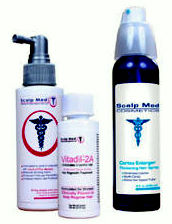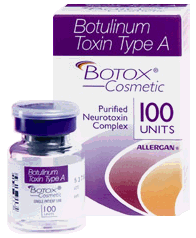Archive for the ‘hair loss products’ Category
Friday, December 25th, 2009

Q:
For thicker eyebrows, Talika hasn’t really worked for me. What’s a better treatment?
A:
There are lots of products which can be found in the cosmetic section, like Talika, which purport to thicken hair. These products, as far as long term solutions, are not really effective in thickening hair shafts or increasing their density. Talika is a type of gel made up of fibers. After applying the gel one time, the eyebrows appear fuller, for a 24-hour period. For some people, this one day-lasting treatment is good enough.
At the present time, there are no agents which can aid in the growth of eyebrows on a long-term basis. A hair transplant for the eyebrows is the only treatment which will have permanent results. After an eyebrow transplant, the patient will have natural hair growing in their eyebrow area. Hair follicles are incised from the scalp so they’ll grow like head hair and will need to be trimmed once every couple of days. A natural eyebrow look will result after the surgery. People who don’t have much head hair may have to undergo several transplants to achieve their desired look.
Tags: eyebrow enhancement, eyebrow enhancer, eyebrow help, eyebrow restoration, eyebrow transplant, talika
Posted in hair loss products, women hair loss | No Comments »
Monday, November 16th, 2009

Q:
Hey Doc:
My hair is as thin as the state of economy; I’m trying to figure out how to make it stronger. Two products I tried are, Chronostin, suggested by my barber; the other one was recommended to me by my psychiatrist: it’s called Minoxidil, Estradiol Vateral, Esopropyl Acohol.
I’d like to hear your expert advice on these products, doc?
Yours truly,
A:
I commend you for seeing a skin doctor. As part of your dermatologist’s diagnosis, I’m quite certain he took a look at you to see if there was miniaturization of hair leading to hair loss in men. Let me add that combining minoxidil with other hormonal medications hasn’t been proven to be a solution to hair loss. You were probably diagnosed with male pattern baldness and then the doctor decided to recommend it. Since that’s what happened, you might also want to try finasteride, a medication much more powerful compared to Minoxidil, based on a few research publications.
The other product, Chronostim, I don’t know what that is. But, being the dedicated doctor I am, I did some of my own research on it. Chronostim is a product that says it is able to act on a group of factors playing a part in hair loss. It has both morning and nighttime treatments.
It contains sabal enriched lauric acid (seborrhea regulating ), tocopherol Nicotinate (microcirculation stimulating, oxygenating bulbar), glycyrrhetinic Acide bta (reinforces the activity of 5-alpha ductase), excipient alcohol-silicone, perfumed- hypoallergenic.
Chronostim, called NIGHT, contains a semblance of Ruscus, enriched in Neoruscine (stimulating of the VEGF), Diguanosine traphosphate (GP4G – cellular stimulant), Piroctonolamine (cleansing, anti-irritant), excipient hydro-alcoholic, perfumed-hypoallergenic.
Clear as the Los Angeles smog, right? To give it to you straight, these products haven’t been proven in any way whatsoever to aid in the treatment of men’s hair loss.
May I be so bold to say, if I were in your shoes, I’d continue taking finasteride (Propecia), if your dermatologist is okay with it. However, if you continue to experience hair loss, a hair transplant would be the best answer.
Best,
Dr. Mohebi
Tags: chronostim, Chronostin, dermatologist, estradiol vateral, finasteride, hair loss product, male pattern hair loss, minoxidil, Propeica, skin doctor
Posted in hair loss medication, hair loss products, hair transplant, men hair restoration | No Comments »
Tuesday, November 10th, 2009
 Q: Q:
Dear Parsa Mohebi,
I hope you’re doing great. I hope you also remember me – it’s —-. I visited your office in January in Mission Viejo, California. I am currently in Dubai! Thank you for the letter which you sent me regarding the tests I should take. I appreciate the time you took out for me. I have taken the tests and wait for the results.
I wanted to ask you a question regarding the hair growth. Recently I was going through some websites and landed on a product called ScalpMed. I was quite alarmed at how this product worked (as it says it does). I am aware that there are numerous type of products available in the market but for some reason this really got me interested. Can you please have a look at it and advice me whether or not to take it seriously?
I appreciate for your time. Looking forward to hear from you!
A:
The hair loss treatment industry is a multi-million dollar business. As such, there are usually companies offering much cheaper, short-cut type products which claim to have the same benefits as more mainstream hair restoration methods.
“I’ve tried hair loss products, but it didn’t work. I don’t think I’ll try it again.”
Most likely, that’s not a line you’ll hear in a commercial for a hair loss product on late night television. But that’s what I think of most of these infomerical-type hair loss treatment goods.
Given the high demand, hair loss products are numerous, but not always effective.
If patients ask me about hair loss products, I like to post them on this blog, as I’m sure there are a lot of people interested in reading about it. Scalp Med is a company which makes numerous products on hair thickening and hair loss treatment. Scalp Med likes to assemble different types of kits for their prospective customers, including a Detoxifying Cleanser Kit, Scalp Med for Women, and Mega-Multi Vitamins.
Like other companies in the hair loss industry, Scalp Med’s advertisements go as far as to say that they are FDA-approved. Any Joe Schmo can find photographs, legit testimonies, and other types of “proof” from balding clients who try to promote Scalp Med’s product.
There are various types of Scalp Med product, including topical Vitadil-5A for men, Vitadil-2A for women, topical NutriSol-RM, and Cortex Enlarger hair thickening spray. The first two Vitadils are topical solutions which contain minoxidil (also Rogaine’s key component). The claim Scalp Med makes is that they have formulated a unique delivery agent which is supposed to increase the absorption of minoxidil in women and men.
For the Scalp Med products NutriSol-RM and Cortex Enlarger thickening spray, we are sort of left in the dark about what exactly is contained in them. Except for minoxidil, the other ingredients contained in these products haven’t been proven to aid in the growth of hair and the health of hair. It’s important to note, the cleansing agents contained in a lot of these types of products do nothing to help a person grow their hair. No matter how clean hair is, it doesn’t help it to grow. Don’t believe the advertising.
I strongly urge you to find out whether your hair loss is treatable. It may stem from some other health condition instead of it being hereditary. If you’re a woman, and you know you have a typical type of female patterned hair baldness, then Rogaine may help.
Sincerely,
Dr. Mohebi
Tags: hair cleanser, hair loss product, hair volumizer, minoxidil, rogaine, Scalp Med, ScalpMed
Posted in California hair transplant, hair loss medication, hair loss products, men hair restoration, women hair loss | No Comments »
Saturday, August 29th, 2009
 A patient sent us an email regarding his hair loss condition. He has male patterned baldness and it is still progressing. He already met with a dermatologist and had several studies done prior to the email and was even using Chronostim for approximately 3 months. Now that he’s used up the bottles of Chronostim, he has noticed no change is his hair loss situation. He wants to have a full head of hair and does not want to take hair loss medication for the rest of his life. Before we forget, his wedding is in 2 months. A patient sent us an email regarding his hair loss condition. He has male patterned baldness and it is still progressing. He already met with a dermatologist and had several studies done prior to the email and was even using Chronostim for approximately 3 months. Now that he’s used up the bottles of Chronostim, he has noticed no change is his hair loss situation. He wants to have a full head of hair and does not want to take hair loss medication for the rest of his life. Before we forget, his wedding is in 2 months.
Chronostim has not been clinically proven to correct or prevent male patterned baldness or any other form of hair loss. It should not be considered a replacement option for medications that have been both proven effective and FDA approved safe for consumption like Propecia (finasteride) DHT blocker.
We highly suggest that all patients experiencing any form of hair loss to be seen by a good hair transplant surgeon and have a miniaturization study done. If the condition is in fact male patterned baldness or androgenetic alopecia, finasteride should be a part of your everyday hair loss treatment plan.
Hair restoration surgery can restore the areas damaged by hair loss by transplanting healthy permanent hair from the donor. In this situation, however, neither of the aforementioned will make enough of a visible difference for the day of your wedding. These procedures take time to show their fullest effect. There are cosmetic options available like Toppik that can cover the balding or thinning areas of your hair through the use of microfibers. If anything, you can use that product for the wedding day while you either consider a hair transplant surgery or at least try using Propecia (finasteride) so that you may see true results a few months after your wedding.
Tags: balding prevention, chronostim, dht, finasteride, hair loss, hair loss product, hair loss treatment, hair transplant, hair transplant surgery, male patterned hairloss, men hair loss, toppik
Posted in hair loss medication, hair loss products, men hair restoration, Uncategorized | No Comments »
Wednesday, August 26th, 2009
Hair loss supplement Biotin is vitamin H (B7) with the chemical formula C10H15N2O3S (you don’t have to memorize it!). It is a water-soluble B-vitamin complex. B-vitamins or Biotin is necessary for healthy cell growth, the metabolism of fats and amino acids, and the production of fatty acids. It plays a role in the acid cycle or the process by which biochemical energy is generated during aerobic respiration. It’s often recommended for use in strengthening hair and nails. It can be found in many cosmetic and health products for hair and nails as well.
Now that we understand Biotin a little bit better, now we can say whether we recommend it or not. Since Biotin is only a vitamin supplement, consumption of this product by healthy individuals will not result in a decrease of hair loss. In fact, intestinal bacteria are produced to consume any excess vitamins in your intestinal tract. Lack of vitamins and minerals may cause hair loss in people with mal-absorption but normal individuals need not worry.
Tags: B-complex, biotin, hair loss, hair loss product, hair loss treatment, hair loss vitamin, vitamin B7, vitamin H
Posted in Bakersfield hair transplant, hair loss medication, hair loss products, men hair restoration, Orange County hair transplant, women hair loss | No Comments »
Sunday, July 12th, 2009
 In a recent email, a patient is going to undergo an additional hair transplant and scar revision. He had done some research in regards to the use of BOTOX injections to help reduce the width of his scar and wonders where and why would you use BOTOX injection, how many units or CCs, and whether it would benefit him. In a recent email, a patient is going to undergo an additional hair transplant and scar revision. He had done some research in regards to the use of BOTOX injections to help reduce the width of his scar and wonders where and why would you use BOTOX injection, how many units or CCs, and whether it would benefit him.
BOTOX injection has been recently introduced to hair transplant surgery for the prevention of scar stretching. There have been a number of patients that have been studied but the research has a very limited number of test subjects. The main purpose of the research was to help compare the effects of BOTOX injection on scar width. One side was treated with BOTOX injection while the other is left alone and the results are recorded during their post hair transplant surgery follow up visits.
It is hard to conclude what the best dosage of BOTOX would be in and around the donor wound because of the limited findings reported. In a recent blog titled Botox Can Reduce Widening of Hair Transplant Scars found in US Hair Restoration Blog, BOTOX helps minimize tension present around the edges of the wound. This action helps collagen mature and the scar wound to form completely.
More studies need to be done to get a much more conclusive answer in regards to the number of units needed and how often BOTOX needs to be reapplied. Because of this, the amount of BOTOX injection needed must be determined by the individual surgeon. This can also change based on the length and size of the hair transplant donor scar. As a note, the injections should not be placed within the first week of post surgery due to the acute inflammatory reaction caused by surgery and should be repeated in 4 month intervals. Muscles tend to get their strength back within or after that time frame.
Tags: Botox, collagen, donor scar, hair transplant, hair transplant surgeon, wound maturation
Posted in hair loss medication, hair loss products, hair transplant | No Comments »
Sunday, June 28th, 2009
Finasteride is the ingredient commonly found in Propecia, a medication used for the treatment of hair loss in men suffering from male pattern baldness. Finasteride is not only used for hair loss. Hair loss prevention is actually the residual side effect of finasteride. The original use of this drug is for prostate enlargement treatment.
Finasteride has been sold under different names and each for a specific cause. Names include Proscar, Propecia, Fincar, Finpecia, Finax, Finast, Finara, Finalo, Prosteride, Gefina, and Finasterid IVAX. Propecia is a 1mg tablet used for hair loss prevention and recommended for hair restoration use by many hair transplant surgeons. It is also the only FDA approved drug for the treatment of hair loss.
Proscar is the original 5mg version of finasteride normally associated with prostate enlargement treatment use. As a cost saving technique, many people purchase 5mg Proscar and cut the tablets into 1.25mg tablets. 1.25mg is a safe dosage but 1mg is more than enough for the treatment of hair loss.
Tags: Finalo, Finara, Finast, Finasterid, Finax, Fincar, Finpecia, Gefina, hair loss treatment, IVAX, prevention of hair loss, propecia, proscar, prostate, Prosteride
Posted in California hair transplant, hair loss medication, hair loss products | No Comments »
Friday, May 22nd, 2009
 We are getting another question on the Propecia use in men whom their wives are pregnant. A hair loss patient just asked about possible side effects that finasteride (Propecia) may cause. He has read on the manufacturer’s instructions that broken tablets must not be handled by women who are or may become pregnant. We are getting another question on the Propecia use in men whom their wives are pregnant. A hair loss patient just asked about possible side effects that finasteride (Propecia) may cause. He has read on the manufacturer’s instructions that broken tablets must not be handled by women who are or may become pregnant.
“Can finasteride cause damage to pregnant womens health or to the health of the developing fetus? Here I’d like to know also if finasteride can be found in body liquids such as men’s saliva, sweat or sperm. In such case is there any risk that a pregnant woman is exposed to finasteride? Are there any recommendations concerning taking or not Propecia before planned or during wife’s pregnancy?”
The answer to this patient’s question, which is a common question that many of young patients may ask is that finasteride (Propecia) blocks the conversion of testosterone to dihydroxytestostrone (DHT). DHT does not have any known role in adult men development, but it is crucial in development of a male fetus and child external genitalia (their penis). We at our Los Angeles, California hair transplant clinics don’t recommend taking finasteride for hair loss prevention and treatment before adulthood while maturation of external genitalia is not completed. Pregnant women should not take finasteride because of its effect on the external genitalia of their male unborn baby.
As we all know, finasteride (Propecia) is designed to block the enzyme that converts testosterone to Dihydrotestosterone (DHT). DHT does not have any real known role in an adult male but it is crucial in the developmental stage of a male fetus as well as the development of a young male’s external genitalia (penis). After reviewing the facts at our Los Angeles, California hair transplant clinics we do not recommend taking finasteride for hair loss prevention and / or treatment before adulthood while maturation of external genitalia is not completed. For this same reason, pregnant women should not take or handle finasteride because of its effects on the male external genitalia of an unborn baby.
Although the pharmaceutical company suggested that pregnant women should not be exposed to finasteride. They should not even be cutting pills that might increase the chance of inhaling small particles of finasteride. You are right about finasteride being present in body secretion such as semen and saliva. However, the amount of the medication is so small that it is considered negligible or safe for pregnant women. So the research shows that it is safe for pregnant women to be exposed to the secretions of a man whom takes finasteride. That is why we do not recommend men to stop taking finasteride if their wife becomes pregnant. There has been no evidence of any risk to a male baby from secretion of finasteride through the father’s saliva, sweat or sperm.
They even mention cutting, ingestion or inhalation of small particles of finasteride to be harmful during pregnancy. You are right to be concerned of finasteride being present in body secretion such as semen and saliva. You can find a very small trace of finasteride in body secretions but the amount of the medication is so small that it is considered negligible or safe for pregnant women. Studies show that pregnant women can be exposed to male secretion even if they are currently taking finasteride. Studies have not found any evidence of risk to a male baby from secretion with trace of finasteride through the father’s saliva, sweat or sperm. So in short we conclude that men do not need to stop using finasteride while having their wives pregnant.
Tags: dht, dihydroxytestostrone, external genitalia, fetus, Finasteride and pregnancy, hair loss, male baby, men hair loss, penis, pregnancy, semen, sperm, sweat
Posted in hair loss medication, hair loss products, men hair restoration | No Comments »
Saturday, May 16th, 2009
 Above: Before and Below: After Latisse Latisse is the name of a new medication that is used for elongation of eyelashes. As a glaucoma medication, biatoprost has been available, used and prescribed to control the progression of glaucoma and to manage ocular hypertension. It is also designed to reduce intraocular pressure. Although biatoprost does what it is designed to do, one of the documented side effects of the glaucoma medication is lengthening of the eyelashes. As of December of 2008, the FDA has approved the use of this product for eyelash lengthening under the name of Latisse by Allergan.
This is a perfect example of an unusual and/or unexpected side effect that has been put to use for its key advantages. Another example is the drug minoxidil which was originally used as a blood pressure medication but as a result of its use, hair growth was reported as a side effect. Now minoxidil is another FDA approved drug used in Rogaine topical for hair loss prevention and treatment.
For people interested in having longer, fuller and natural eyelashes without surgery or makeup, Latisse is the best option available by prescription. Eyelash hair transplant surgery is another method that would use scalp hair to be implanted into the eyelash area as well. The best candidates for eyelash hair transplant surgery are people whom have little or no eyelashes on all or part of their eyelash area. If you have eyelashes and are looking into making them longer and fuller, Latisse might be your best option.
If you are interested in ordering Latisse, please contact us at 888-302-8747. We do have a special rates for Spring of 2009.
Tags: eyelash hair restoration, latisse
Posted in hair loss medication, hair loss products, women hair loss | No Comments »
Monday, May 4th, 2009
 In a recent article published in the Journal of Investigative Dermatology (January 2009), the Department of Dermatology at the University of L’beck in L’beck, Germany and Zhejiang University in Hangzhou, China had shown that excessive exposure to UV radiation is among the most harmful environmental influences on human skin. There have been findings that direct sunlight and ultraviolet radiation can negatively affect the growth of hair follicles. In a recent article published in the Journal of Investigative Dermatology (January 2009), the Department of Dermatology at the University of L’beck in L’beck, Germany and Zhejiang University in Hangzhou, China had shown that excessive exposure to UV radiation is among the most harmful environmental influences on human skin. There have been findings that direct sunlight and ultraviolet radiation can negatively affect the growth of hair follicles.
There research was conducted on organ-cultured human anagen hair follicles in vitro and were irradiated with UVB, one of two common types of Ultra Violet light. What was observed was reduction of hair shaft elongation, premature catagen entry and reduced hair matrix keratinocyte proliferation.
When the hair follicles were exposed to UVB at lower powers, apoptotic cell death prevailed and at higher power necrotic cell death was predominant. Investigators at both universities corroborated and concluded the UVR does modify hair growth and cycle, can promote cell death and encourages regulatory events in human hair follicles in vitro. The human organ model, which is composed of living human tissue in situ conditions, was used in their findings and encourages its further use for general investigation of UV effects.
Because of these relevant findings, we recommend all of our patients, pre and post operative, to minimize sun exposure on unprotected parts of their body and especially their scalp area. We personally have a No Sun Exposure policy for 6 months after hair transplant surgery for all our patients.
Tags: hair growth, hair loss, sun exposure, UV radiation
Posted in hair loss products, hair transplant | No Comments »
|
|








